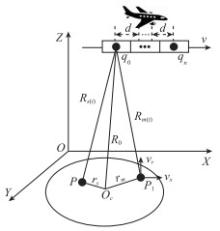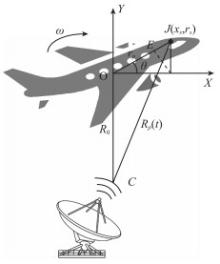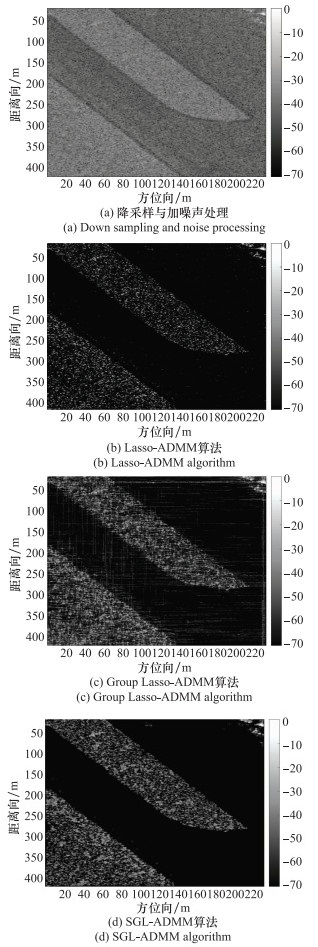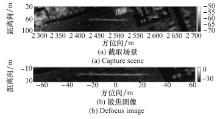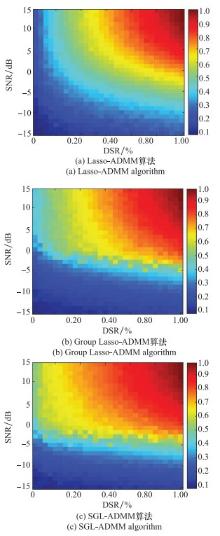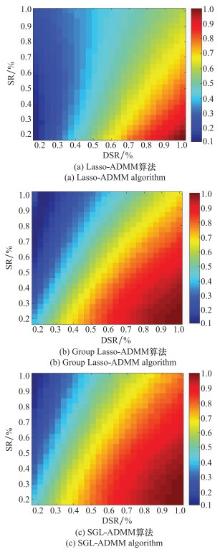Systems Engineering and Electronics ›› 2021, Vol. 43 ›› Issue (2): 351-362.doi: 10.12305/j.issn.1001-506X.2021.02.09
• Sensors and Signal Processing • Previous Articles Next Articles
High resolution SAR imagery with structural feature enhancement under two-layer sparse group Lasso
Lei YANG1,*( ), Huijuan LI1(
), Huijuan LI1( ), Bo HUANG2(
), Bo HUANG2( ), Wei LIU1(
), Wei LIU1( ), Pucheng LI1(
), Pucheng LI1( )
)
- 1. Tianjin Key Laboratory for Advanced Signal Processing, Civil Aviation University of China, Tianjin 300300, China
2. Institute of Electronic Engineering, Chinese Academy of Engineering Physics, Mianyang 621999, China
-
Received:2020-04-20Online:2021-02-01Published:2021-03-16 -
Contact:Lei YANG E-mail:yanglei840626@163.com;mearing@foxmail.com;vick123y@163.com;1763026755@qq.com;pucklee1111@163.com
CLC Number:
Cite this article
Lei YANG, Huijuan LI, Bo HUANG, Wei LIU, Pucheng LI. High resolution SAR imagery with structural feature enhancement under two-layer sparse group Lasso[J]. Systems Engineering and Electronics, 2021, 43(2): 351-362.
share this article
| 1 | 邵宁远, 邹焕新, 陈诚, 等. 面向变化检测的SAR图像超像素协同分割算法[J]. 系统工程与电子技术, 2019, 41 (7): 1496- 1503. |
| SHAO N Y , ZOU H X , CHEN C , et al. Change detection-oriented super-pixel cosegmentation algorithm for SAR images[J]. Systems Engineering and Electronics, 2019, 41 (7): 1496- 1503. | |
| 2 | 杜毅, 廖可非, 欧阳缮, 等. ISAR成像系统的二维资源自适应调度算法[J]. 系统工程与电子技术, 2020, 42 (2): 339- 345. |
| DU Y , LIAO K F , OUYANG S , et al. Two-dimensional resource scheduling algorithm for ISAR imaging system[J]. Systems Engineering and Electronics, 2020, 42 (2): 339- 345. | |
| 3 |
DONOHO D L . Compressed sensing[J]. IEEE Trans.on Information Theory, 2006, 52 (4): 1289- 1306.
doi: 10.1109/TIT.2006.871582 |
| 4 | LORT M , AGUASCA A , LÓPEZ-MARTÍNEZ C , et al. Initial evaluation of SAR capabilities in UAV multicopter platforms[J]. IEEE Journal of Selected Topics in Applied Earth Observations & Remote Sensing, 2018, 11 (1): 1- 14. |
| 5 | YANG L , ZHAO L F , BI G A , et al. SAR ground moving target imaging algorithm based on parametric and dynamic sparse Bayesian learning[J]. IEEE Trans.on Geoscience and Remote Sensing, 2016, 54 (2): 2254- 2267. |
| 6 |
XU G , GAO Y D , LI J W , et al. InSAR phase denoising:a review of current technologies and future directions[J]. IEEE Geo-science Remote Sensing Magazine, 2020, 8 (2): 64- 82.
doi: 10.1109/MGRS.2019.2955120 |
| 7 |
ZHOU D Y , YIN X Y , ZONG Z Y . Multi-trace basis-pursuit seismic inversion for resolution enhancement[J]. Geophysical Prospecting, 2019, 67 (3): 519- 531.
doi: 10.1111/1365-2478.12752 |
| 8 |
WANG Y J , LIN W C , CHENG S , et al. Sharp and laterally constrained multitrace impedance inversion based on blocky coordinate descent[J]. Acta Geophysica, 2018, 66 (4): 623- 631.
doi: 10.1007/s11600-018-0160-z |
| 9 | BOYD S , PARIKH N , CHU E , et al. Distributed optimization and statistical learning via the alternating direction method of multipliers[J]. Foundations and Trends in Machine Learning, 2011, 3 (1): 1- 122. |
| 10 |
YANG L , LI P C , ZHANG S , et al. Cooperative multitask learning for sparsity-driven SAR imagery and nonsystematic error autocalibration[J]. IEEE Trans.on Geoscience and Remote Sensing, 2020, 58 (7): 5132- 5147.
doi: 10.1109/TGRS.2020.2972972 |
| 11 |
杨磊, 李埔丞, 李慧娟, 等. 稳健高效通用SAR图像稀疏特征增强算法[J]. 电子与信息学报, 2019, 41 (12): 2826- 2835.
doi: 10.11999/JEIT190173 |
|
YANG L , LI P C , LI H J , et al. Robust and efficient general SAR image sparse feature enhancement algorithm[J]. Journal of Electronics and Information Technology, 2019, 41 (12): 2826- 2835.
doi: 10.11999/JEIT190173 |
|
| 12 |
YUAN M , LIN Y . Model selection and estimation in regression with grouped variables[J]. Journal of the Royal Statistical Society Series B, 2006, 68, 49- 67.
doi: 10.1111/j.1467-9868.2005.00532.x |
| 13 |
ZHAO L F , WANG L , BI G A , et al. An autofocus technique for high-resolution inverse synthetic aperture radar imagery[J]. IEEE Trans.on Geoscience and Remote Sensing, 2014, 52 (10): 6392- 6403.
doi: 10.1109/TGRS.2013.2296497 |
| 14 | 吴辰阳, 魏中浩, 张冰尘, 等. 基于复近似信息传递的多通道SAR成像方法[J]. 系统工程与电子技术, 2018, 40 (6): 1249- 1254. |
| WU C Y , WEI Z H , ZHANG B C , et al. Multi-channel SAR imaging method based on CAMP[J]. Systems Engineering and Electronics, 2018, 40 (6): 1249- 1254. | |
| 15 |
张云鹏, 毕大平, 房明星, 等. 多通道SAR-GMTI二维间歇采样延时转发干扰[J]. 系统工程与电子技术, 2017, 39 (11): 2448- 2455.
doi: 10.3969/j.issn.1001-506X.2017.11.09 |
|
ZHANG Y P , BI D P , FANG M X , et al. 2D intermittent sampling time-delay repeater jamming to multi-channel SAR-GMTI[J]. Systems Engineering and Electronics, 2017, 39 (11): 2448- 2455.
doi: 10.3969/j.issn.1001-506X.2017.11.09 |
|
| 16 |
YANG L , BI G A , XING M D , et al. Airborne SAR moving target signatures and imagery based on LVD[J]. IEEE Trans.on Geoscience and Remote Sensing, 2015, 53 (11): 5958- 5971.
doi: 10.1109/TGRS.2015.2429678 |
| 17 | TIBSHIRANI R J . Regression shrinkage and selection via the Lasso[J]. Journal of the Royal Statistical Society, 1996, 58 (1): 267- 288. |
| 18 | DUNGAN K E, AUSTIN C, NEHRBASS J, et al.Civilian vehicle radar data domes[C]//Proc.of the SPIE Algorithms for Synthetic Aperture Radar Imagery XVII, 2010: 731-739. |
| 19 |
KRAGH T J . Monotonic iterative algorithm for minimum-entropy autofocus[J]. IEEE Trans.on Information Theory, 2011, 57 (10): 6920- 6941.
doi: 10.1109/TIT.2011.2165823 |
| 20 |
黄石生, 王正明, 王卫威. 基于正则模型的SAR图像自适应目标特征增强方法[J]. 数据采集与处理, 2009, 24 (3): 304- 308.
doi: 10.3969/j.issn.1004-9037.2009.03.010 |
|
HUANG S S , WANG Z M , WANG W W . An adaptive target feature enhancement method for SAR image based on regular model[J]. Journal of Data Acquisition and Processing, 2009, 24 (3): 304- 308.
doi: 10.3969/j.issn.1004-9037.2009.03.010 |
|
| 21 | DONOHO D L , MALEKI A , MONTANARI A . The noise-sensitivity phase transition in compressed sensing[J]. IEEE Trans.on Information Theory, 2010, 57 (10): 6920- 6941. |
| [1] | Tian MIAO, Hongcheng ZENG, He WANG, Jie CHEN. A fast extraction method of flood areas based on iterative threshold segmentation using spaceborne SAR data [J]. Systems Engineering and Electronics, 2022, 44(9): 2760-2768. |
| [2] | Caiyun WANG, Yida WU, Jianing WANG, Lu MA, Huanyue ZHAO. SAR image target recognition based on combinatorial optimization convolutional neural network [J]. Systems Engineering and Electronics, 2022, 44(8): 2483-2487. |
| [3] | Dongning FU, Guisheng LIAO, Yan HUANG, Bangjie ZHANG, Xing WANG. Time-varying narrow-band interference suppression algorithm for SAR based on graph Laplacian embedding [J]. Systems Engineering and Electronics, 2022, 44(6): 1846-1853. |
| [4] | Minghui GAI, Su ZHANG, Weitian SUN, Yude NI, Lei YANG. Structural-feature enhancement of SAR targets based on complex value compatible total variation [J]. Systems Engineering and Electronics, 2022, 44(6): 1862-1872. |
| [5] | Penghui JI, Dahai DAI, Shiqi XING, Dejun FENG. Dense false moving targets generation method [J]. Systems Engineering and Electronics, 2022, 44(5): 1502-1511. |
| [6] | Dong CHEN, Yanwei JU. Ship object detection SAR images based on semantic segmentation [J]. Systems Engineering and Electronics, 2022, 44(4): 1195-1201. |
| [7] | Lei YANG, Su ZHANG, Minghui GAI, Cheng FANG. High-resolution SAR imagery with enhancement of directional structure feature [J]. Systems Engineering and Electronics, 2022, 44(3): 808-818. |
| [8] | Xi ZHANG, Zhengmeng JIN, Yaqin JIANG. Total variation algorithm with depth image priors for image colorization [J]. Systems Engineering and Electronics, 2022, 44(2): 385-393. |
| [9] | Junjie WANG, Dejun FENG, Weidong HU. Two-dimensional SAR image modulation method based on time-varying materials [J]. Systems Engineering and Electronics, 2022, 44(2): 455-462. |
| [10] | Cheng FANG, Huijuan LI, Wen LU, Yumeng SONG, Lei YANG. Multi-feature enhancement algorithm for high resolution SAR based on morphological auto-blocking [J]. Systems Engineering and Electronics, 2022, 44(2): 470-479. |
| [11] | Yu LEI, Xiangguang LENG, Xiaoyan ZHOU, Zhongzhen SUN, Kefeng JI. Recognition method of ship target in complex SAR image based on improved ResNet network [J]. Systems Engineering and Electronics, 2022, 44(12): 3652-3660. |
| [12] | Xiaoya JIA, Hongqiao WANG, Yadan YANG, Zhongma CUI, Bin XIONG. Anchor free SAR image ship target detection method based on the YOLO framework [J]. Systems Engineering and Electronics, 2022, 44(12): 3703-3709. |
| [13] | Zheng XU, Guangzhong GONG, Yunhua LUO, Guangde LI. Application of improved spatial variant apodization algorithm through constrained optimization in sidelobe suppression [J]. Systems Engineering and Electronics, 2022, 44(11): 3298-3304. |
| [14] | Baoping YANG, Maogang WEI, Zhichao BAO, Linsen YANG, Xiaoyu WANG. Comparative analysis of common coherent jamming technology against SAR [J]. Systems Engineering and Electronics, 2022, 44(11): 3397-3402. |
| [15] | Guang SUN, Shiqi XING, Datong HUANG, Yongzhen LI, Xuesong WANG. Jamming method of intermittent sampling against SAR-GMTI based on noise multiplication modulation [J]. Systems Engineering and Electronics, 2022, 44(10): 3059-3071. |
| Viewed | ||||||
|
Full text |
|
|||||
|
Abstract |
|
|||||
